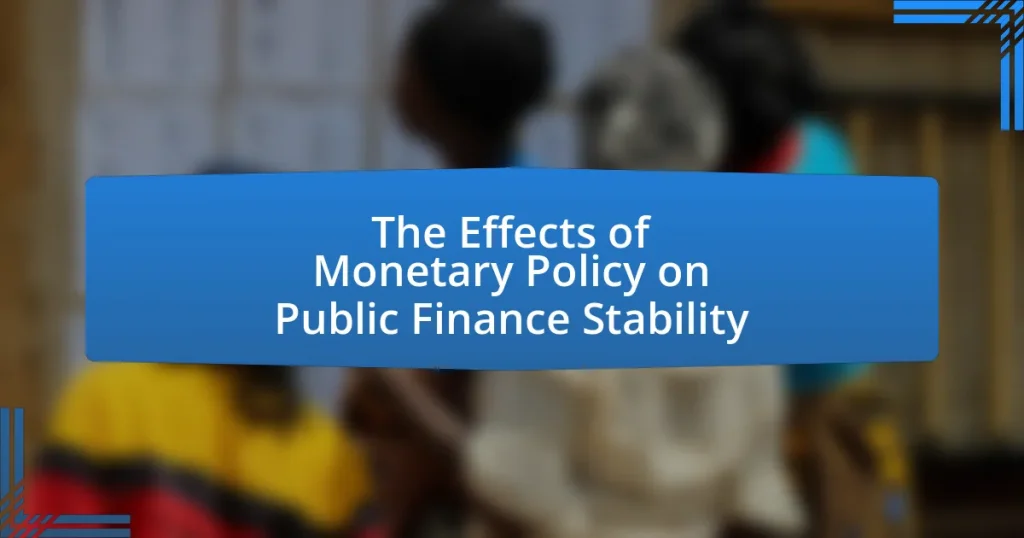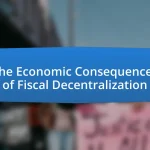The article examines the effects of monetary policy on public finance stability, highlighting how interest rates, inflation, and government borrowing are interconnected. It discusses the influence of monetary policy on government revenue and expenditure, emphasizing the mechanisms that link these elements, such as tax revenues and public spending decisions. The article also explores the importance of public finance stability for economic growth, investor confidence, and social welfare programs, while detailing the types of monetary policy and their differing impacts. Additionally, it addresses external factors that affect the relationship between monetary policy and public finance, and offers strategies for policymakers to mitigate negative effects and enhance fiscal resilience.

What are the Effects of Monetary Policy on Public Finance Stability?
Monetary policy significantly influences public finance stability by affecting interest rates, inflation, and government borrowing. When central banks adjust interest rates, it alters the cost of borrowing for governments, impacting their fiscal policies and budgetary decisions. For instance, lower interest rates can reduce debt servicing costs, allowing governments to allocate more resources to public services, thereby enhancing fiscal stability. Conversely, high interest rates can increase borrowing costs, leading to tighter budgets and potential fiscal stress. Additionally, monetary policy affects inflation rates; stable inflation fosters a predictable economic environment, which is crucial for sound public finance management. Historical data shows that countries with stable monetary policies tend to experience lower public debt levels and improved fiscal health, as evidenced by the correlation between inflation targeting and reduced budget deficits in various economies.
How does monetary policy influence government revenue and expenditure?
Monetary policy influences government revenue and expenditure primarily through interest rates and inflation control. When a central bank adjusts interest rates, it affects borrowing costs for the government and consumers, which in turn impacts tax revenues. For instance, lower interest rates can stimulate economic growth, leading to increased income tax revenues as businesses and individuals earn more. Conversely, higher interest rates can slow down economic activity, reducing tax revenues.
Additionally, monetary policy affects government expenditure by influencing the cost of servicing public debt. If interest rates rise, the government faces higher costs for existing debt, which can lead to reduced spending in other areas. Historical data shows that during periods of high inflation, such as the 1970s, governments often faced increased expenditure due to rising costs, while revenue growth lagged, impacting overall fiscal stability. Thus, the interplay between monetary policy, interest rates, and inflation directly shapes government revenue and expenditure dynamics.
What mechanisms link monetary policy to tax revenues?
Monetary policy influences tax revenues primarily through interest rates, inflation, and economic growth. When a central bank adjusts interest rates, it affects borrowing costs for consumers and businesses, which in turn influences spending and investment. Lower interest rates typically stimulate economic activity, leading to higher income levels and increased tax revenues. Conversely, higher interest rates can dampen economic growth, resulting in lower tax revenues.
Inflation, managed through monetary policy, also impacts tax revenues. Moderate inflation can increase nominal income levels, thereby raising tax revenues without changing tax rates. However, excessive inflation can erode purchasing power and complicate tax collection.
Additionally, monetary policy affects overall economic stability, which is crucial for sustainable tax revenues. For instance, during economic downturns, tax revenues often decline due to reduced income and consumption, while expansionary monetary policy can help stabilize the economy and support revenue growth. Historical data shows that countries with effective monetary policies tend to experience more stable tax revenues, reinforcing the link between these mechanisms.
How does monetary policy affect public spending decisions?
Monetary policy affects public spending decisions primarily through interest rates and inflation control. When a central bank adjusts interest rates, it influences borrowing costs for governments; lower rates typically encourage increased public spending as financing becomes cheaper, while higher rates can lead to reduced spending due to increased costs of debt servicing. For instance, during the 2008 financial crisis, the Federal Reserve lowered interest rates to stimulate economic activity, which led to increased public investment in infrastructure and social programs. Additionally, monetary policy impacts inflation expectations, which can affect budgetary planning; if inflation is anticipated to rise, governments may allocate more funds to maintain purchasing power, thereby influencing overall public spending decisions.
Why is public finance stability important for economic growth?
Public finance stability is crucial for economic growth because it fosters a predictable environment for investment and consumption. When public finances are stable, governments can maintain consistent fiscal policies, which reduces uncertainty for businesses and consumers. This stability encourages long-term investments, as firms are more likely to commit resources when they can anticipate future tax rates and government spending. Historical evidence shows that countries with stable public finances, such as Germany and Canada, have experienced more robust economic growth compared to those with volatile fiscal policies, like Greece during its debt crisis. Thus, the correlation between public finance stability and economic growth is supported by the ability of stable fiscal environments to promote investment and consumer confidence.
What role does public finance stability play in investor confidence?
Public finance stability significantly enhances investor confidence by providing a predictable and secure economic environment. When a government maintains stable public finances, characterized by manageable debt levels and balanced budgets, it signals to investors that the country is capable of meeting its financial obligations. For instance, according to the International Monetary Fund, countries with stable fiscal policies tend to attract more foreign direct investment, as investors seek to minimize risk. This stability reduces uncertainty regarding future tax policies and government spending, which are critical factors influencing investment decisions. Therefore, the correlation between public finance stability and heightened investor confidence is evident in the positive economic outcomes observed in nations that prioritize fiscal responsibility.
How does public finance stability impact social welfare programs?
Public finance stability significantly enhances the effectiveness and sustainability of social welfare programs. When public finance is stable, governments can allocate resources more predictably and efficiently, ensuring that social welfare programs receive consistent funding. For instance, during periods of fiscal stability, countries can maintain or increase social spending, which has been shown to reduce poverty rates and improve overall social outcomes. According to the International Monetary Fund, nations with stable fiscal policies are better positioned to invest in social programs, leading to improved health and education indicators. This correlation underscores the importance of public finance stability in fostering robust social welfare systems.

What are the different types of monetary policy?
The different types of monetary policy are expansionary monetary policy and contractionary monetary policy. Expansionary monetary policy aims to increase the money supply and lower interest rates to stimulate economic growth, often implemented during periods of recession. For instance, the Federal Reserve lowered interest rates significantly during the 2008 financial crisis to encourage borrowing and investment. Conversely, contractionary monetary policy seeks to reduce the money supply and increase interest rates to curb inflation, typically enacted when the economy is overheating. An example includes the Federal Reserve’s actions in the late 1970s and early 1980s to combat high inflation by raising interest rates. These two types of monetary policy directly influence public finance stability by affecting government borrowing costs and overall economic activity.
How do expansionary and contractionary policies differ in their effects?
Expansionary and contractionary policies differ primarily in their impact on economic activity and inflation. Expansionary policies, such as lowering interest rates or increasing government spending, aim to stimulate economic growth by increasing the money supply, which can lead to higher consumer spending and investment. For example, during the 2008 financial crisis, the Federal Reserve implemented expansionary measures, resulting in a significant increase in liquidity and a gradual recovery in economic activity.
In contrast, contractionary policies, which involve raising interest rates or reducing government spending, are designed to slow down an overheating economy and control inflation. For instance, in the late 1970s, the Federal Reserve raised interest rates to combat high inflation, which ultimately led to a recession but successfully reduced inflation rates over time. Thus, while expansionary policies seek to boost economic activity, contractionary policies aim to restrain it, with each having distinct effects on inflation and overall economic stability.
What are the short-term effects of expansionary monetary policy on public finance?
Expansionary monetary policy leads to increased government revenue and reduced borrowing costs in the short term. When a central bank lowers interest rates or purchases government securities, it stimulates economic activity, which can enhance tax revenues as businesses and consumers spend more. For instance, during the 2008 financial crisis, the Federal Reserve’s expansionary measures helped lower interest rates, resulting in a temporary boost in tax collections as economic activity picked up. Additionally, lower interest rates reduce the cost of servicing existing public debt, allowing governments to allocate more resources to other areas. This dynamic illustrates how expansionary monetary policy can positively impact public finance in the short run.
How does contractionary monetary policy influence public debt levels?
Contractionary monetary policy typically leads to higher public debt levels. This occurs because such policies, which involve raising interest rates and reducing money supply, can slow economic growth and increase borrowing costs for governments. As a result, governments may need to issue more debt to finance deficits that arise from lower tax revenues and increased interest payments on existing debt. Historical data from the 2008 financial crisis shows that countries implementing contractionary measures experienced a rise in public debt as they struggled to maintain fiscal stability amidst declining economic activity.
What tools do central banks use to implement monetary policy?
Central banks use several tools to implement monetary policy, including open market operations, the discount rate, and reserve requirements. Open market operations involve the buying and selling of government securities to influence the money supply and interest rates. The discount rate is the interest rate charged to commercial banks for short-term loans from the central bank, which affects lending rates throughout the economy. Reserve requirements dictate the minimum reserves each bank must hold against deposits, directly impacting the amount of money banks can lend. These tools are essential for managing inflation, stabilizing the currency, and promoting economic growth, as evidenced by their use during various economic crises to maintain financial stability.
How do interest rate adjustments affect public finance stability?
Interest rate adjustments significantly impact public finance stability by influencing government borrowing costs and overall economic activity. When interest rates rise, the cost of servicing existing debt increases, which can strain public budgets and lead to reduced public spending. For instance, a 1% increase in interest rates can raise debt service costs by billions for governments, as seen in the U.S. during the 2018 rate hikes, where the Congressional Budget Office projected an increase in interest payments by approximately $100 billion over a decade. Conversely, lower interest rates can reduce borrowing costs, allowing governments to invest more in public services and infrastructure, thereby stabilizing or enhancing public finance. This relationship underscores the critical role of monetary policy in shaping fiscal outcomes and maintaining public finance stability.
What is the impact of quantitative easing on government budgets?
Quantitative easing (QE) impacts government budgets primarily by lowering borrowing costs and increasing government revenue through enhanced economic activity. When central banks implement QE, they purchase government securities, which injects liquidity into the economy, leading to lower interest rates. This reduction in rates allows governments to issue debt at cheaper costs, thereby decreasing interest payments on existing debt. For instance, during the post-2008 financial crisis, the U.S. Federal Reserve’s QE programs significantly lowered yields on Treasury bonds, resulting in reduced interest expenses for the federal budget. Additionally, as QE stimulates economic growth, it can lead to higher tax revenues, further improving budgetary positions. This relationship between QE, lower borrowing costs, and increased revenue illustrates its substantial impact on government budgets.

How do external factors influence the relationship between monetary policy and public finance stability?
External factors significantly influence the relationship between monetary policy and public finance stability by affecting economic conditions and government revenue. For instance, global economic trends, such as commodity price fluctuations or international trade dynamics, can impact inflation rates and interest rates, which are central to monetary policy. When commodity prices rise, it can lead to increased inflation, prompting central banks to tighten monetary policy, which may reduce government borrowing capacity and affect public finance stability. Additionally, geopolitical events can disrupt markets and investor confidence, leading to volatility in exchange rates and capital flows, further complicating the effectiveness of monetary policy in maintaining public finance stability. Historical examples include the 2008 financial crisis, where external shocks led to significant changes in monetary policy and subsequent impacts on public finance across various countries.
What role do global economic conditions play in shaping monetary policy?
Global economic conditions significantly influence monetary policy by affecting inflation rates, employment levels, and overall economic growth. Central banks, such as the Federal Reserve, adjust interest rates and implement quantitative easing based on global economic indicators like GDP growth, trade balances, and international financial stability. For instance, during the 2008 financial crisis, central banks worldwide lowered interest rates to stimulate economies, demonstrating how interconnected global conditions necessitate coordinated monetary responses. Additionally, fluctuations in global commodity prices can lead to inflationary pressures, prompting central banks to modify their policies to maintain price stability.
How do exchange rates affect public finance stability in a country?
Exchange rates significantly impact public finance stability in a country by influencing government revenues, expenditures, and overall economic growth. When a country’s currency depreciates, the cost of imported goods rises, leading to increased inflation, which can strain public budgets. For instance, in 2018, Argentina experienced a sharp depreciation of its peso, resulting in higher costs for imported goods and services, which negatively affected public spending and increased the fiscal deficit. Conversely, a stronger currency can reduce the cost of imports and help stabilize prices, potentially improving public finance stability. Historical data shows that countries with volatile exchange rates often face greater challenges in maintaining fiscal discipline, as fluctuations can disrupt revenue projections and complicate budget planning.
What impact do international trade dynamics have on monetary policy effectiveness?
International trade dynamics significantly influence the effectiveness of monetary policy by altering exchange rates, inflation rates, and capital flows. When a country engages in international trade, changes in trade balances can affect domestic currency value, which in turn impacts inflation and interest rates. For instance, an increase in exports can lead to currency appreciation, making imports cheaper and potentially lowering inflation. Conversely, a trade deficit may weaken the currency, leading to higher import prices and inflationary pressures.
Research by the International Monetary Fund indicates that countries with open trade policies often experience more pronounced effects of monetary policy due to the interconnectedness of global markets. This interconnectedness can lead to challenges in achieving domestic monetary goals, as external shocks from trade partners can disrupt local economic conditions. Thus, the dynamics of international trade play a crucial role in shaping the landscape within which monetary policy operates, affecting its overall effectiveness.
How can policymakers mitigate negative effects of monetary policy on public finance?
Policymakers can mitigate the negative effects of monetary policy on public finance by implementing counter-cyclical fiscal policies. These policies involve increasing government spending or cutting taxes during economic downturns to stimulate demand, which can offset the contractionary effects of tight monetary policy. For instance, during the 2008 financial crisis, many governments increased public spending to support economic activity, which helped stabilize public finance despite restrictive monetary conditions. Additionally, enhancing the efficiency of public spending and improving tax collection can strengthen public finance resilience against monetary policy fluctuations. Historical data shows that countries with robust fiscal frameworks are better equipped to handle the adverse impacts of monetary policy changes, thereby maintaining public finance stability.
What strategies can be employed to enhance fiscal resilience during monetary policy shifts?
To enhance fiscal resilience during monetary policy shifts, governments can implement counter-cyclical fiscal policies, maintain diversified revenue sources, and strengthen fiscal frameworks. Counter-cyclical fiscal policies, such as increasing public spending during economic downturns, can stabilize demand and support economic activity, as evidenced by the effectiveness of stimulus measures during the 2008 financial crisis. Maintaining diversified revenue sources, including taxes, fees, and grants, reduces reliance on any single income stream, thereby mitigating risks associated with monetary policy changes. Strengthening fiscal frameworks, such as establishing fiscal rules and transparent budgeting processes, enhances accountability and promotes sustainable fiscal management, which is crucial during periods of monetary policy volatility.
How can governments balance monetary policy with fiscal responsibility?
Governments can balance monetary policy with fiscal responsibility by coordinating their strategies to ensure economic stability while managing public debt. Effective coordination involves aligning interest rates set by central banks with government spending and taxation policies to stimulate growth without excessive borrowing. For instance, during economic downturns, central banks may lower interest rates to encourage borrowing and investment, while governments can implement targeted fiscal measures to support vulnerable sectors. Historical examples, such as the coordinated response during the 2008 financial crisis, illustrate that when monetary policy is aligned with fiscal measures, it can lead to quicker economic recovery and reduced public debt levels. This approach ensures that monetary policy supports fiscal responsibility, maintaining public finance stability.
What best practices should be followed to ensure public finance stability amidst changing monetary policies?
To ensure public finance stability amidst changing monetary policies, governments should adopt a framework of fiscal discipline, transparency, and adaptability. Fiscal discipline involves maintaining balanced budgets and controlling public debt levels, which can mitigate the risks associated with fluctuating interest rates and inflation. For instance, countries like Germany have successfully implemented strict fiscal rules that limit budget deficits, contributing to economic stability.
Transparency in public finance management allows for better stakeholder engagement and trust, which can enhance the effectiveness of fiscal policies. The International Monetary Fund (IMF) emphasizes that transparent budgeting processes lead to improved fiscal outcomes, as they enable citizens to hold governments accountable.
Lastly, adaptability is crucial; governments must be prepared to adjust fiscal policies in response to changing economic conditions. Historical examples, such as the swift fiscal responses during the 2008 financial crisis, demonstrate that timely adjustments can stabilize economies and maintain public finance integrity.


